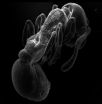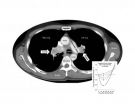(Press-News.org) Nearly one in 12 American stroke survivors may have contemplated suicide or wished themselves dead, according to a study presented at the American Stroke Association's International Stroke Conference 2013.
The proportion of stroke survivors who contemplated suicide was striking, compared with patients with other health conditions, said Amytis Towfighi, M.D., lead author of the study and an assistant professor of Clinical Neurology at the University of Southern California in Los Angeles and chair of the Department of Neurology at Rancho Los Amigos National Rehabilitation Center.
In a nationally representative sample of the U.S. population, 7.8 percent of stroke survivors reported suicidal thoughts, compared to 6.2 percent of heart attack survivors, 5.2 percent of diabetes patients and 4.1 percent of cancer patients.
"Given the high prevalence of suicidal thoughts among stroke survivors, perhaps regular screening for suicidal ideation, in addition to depression, is warranted," Towfighi said.
About 7 million U.S. adults have a history of stroke, according to American Stroke Association statistics. About one third of stroke survivors develop depression, but there is little data on suicidal thoughts, Towfighi said.
Researchers investigated how many stroke survivors had recent suicidal thoughts, as well as the characteristics of these patients using data from the National Health and Nutrition Examination Surveys (NHANES) conducted from 2005 to 2010. During that time, an estimated 6.2 million U.S. adults were stroke survivors.
NHANES is an ongoing series of elaborate, cross-sectional surveys providing a snapshot of Americans' health. This study focused on participants' responses to the following question: "Over the past two weeks, how often have you been bothered by thoughts that you would be better off dead, or of hurting yourself in some way?"
Stroke survivors were more likely to have suicidal thoughts if they had a higher depression score, were younger, had higher body mass index, lower education level, lower poverty index, were single and were women.
Among the stroke survivors, 17 percent suffered from depression. Depression is the most common psychological complication after stroke. "Post-stroke depression can be associated with poorer functional outcomes, worse quality of life, higher mortality, low psychological well-being, suicidal ideation and suicide," Towfighi said.
The researchers haven't calculated what percentage of all NHANES participants, stroke survivors or not, might be suicidal. But Towfighi cited previous studies which found an annual suicide rate that was nearly double the expected figure for the population as a whole.
The cross-sectional design of the study didn't allow researchers to determine cause-and-effect relationships between stroke and suicidal thoughts. Additionally, the NHANES data didn't include information about how recently people's strokes had occurred, or whether the strokes were due to a ruptured blood vessel (hemorrhagic stroke) or a blocked blood vessel in the brain (ischemic stroke). The study also didn't account for patients' varying levels of disability.
###
Co-authors are Daniela Markovic, M.S., and Bruce Ovbiagele, M.D., M.Sc., M.A.S. Author disclosures are on the abstract.
Follow news from the ASA International Stroke Conference 2013 via Twitter @HeartNews; #ISC13.
To reach a suicide crisis center in your area call -800-273-TALK or visit hopeline.com. Learn more about life after stroke.
Statements and conclusions of study authors that are presented at American Stroke Association scientific meetings are solely those of the study authors and do not necessarily reflect association policy or position. The association makes no representation or warranty as to their accuracy or reliability. The association receives funding primarily from individuals; foundations and corporations (including pharmaceutical, device manufacturers and other companies) also make donations and fund specific association programs and events. The association has strict policies to prevent these relationships from influencing the science content. Revenues from pharmaceutical and device corporations are available at www.heart.org/corporatefunding.
Note: Actual presentation of this moderated poster is 4:20 pm HT, Thursday, Feb. 7, 2013.
All downloadable video/audio interviews, B-roll, animation and images related to this news release are located on the right column of the release link. Video clips with researchers/authors of studies will be added to the release links after embargo.
Almost 8 percent of US stroke survivors may have suicidal thoughts
Abstract: TMP92
2013-02-07
ELSE PRESS RELEASES FROM THIS DATE:
Infant, child stroke survivors prone to seizures, epilepsy
2013-02-07
About one-third of American infants and children who suffer bleeding into brain tissue, may later have seizures and as many as 13 percent will develop epilepsy within two years, according to new research reported at the American Stroke Association's International Stroke Conference 2013.
Bleeding into brain tissue is a type of stroke called intracerebral hemorrhage (ICH). Each year, an estimated 6.4 newborns and children per every 100,000 in the United States suffer strokes. About half of the strokes are hemorrhagic, typically caused by rupturing of weakened or malformed ...
Some stroke patients whose life support is withdrawn may have achieved a less-than-ideal
2013-02-07
More than a third of patients who suffer a major bleeding in the brain and have their life support withdrawn might have eventually regained an acceptable level of functioning if life support had been sustained, suggests a new study presented at the American Stroke Association's International Stroke Conference 2013.
In the United States, 10 percent of the estimated 795,000 strokes each year are intracerebral hemorrhages (ICH). ICH is the most common type of bleeding stroke and it occurs when a weakened blood vessel inside the brain ruptures and leaks blood into surrounding ...
Magnetic map guides salmon home
2013-02-07
For sockeye salmon coming home after years spent at sea, a magnetic map is apparently responsible for their remarkable sense of direction. That's according to an analysis of data collected over 56 years and reported online on February 7 in Current Biology, a Cell Press publication.
"To find their way back home across thousands of kilometers of ocean, salmon imprint on the magnetic field that exists where they first enter the sea as juveniles," said Nathan Putman of Oregon State University. "Upon reaching maturity, they seek the coastal location with the same magnetic ...
For ant pupae, status means being heard
2013-02-07
AUDIO:
This is a recording of ant pupa sound.
Click here for more information.
For young ants at the pupal stage of life—caught between larva and adulthood—status is all about being heard. The findings, reported online on February 7 in Current Biology, a Cell Press publication, add to evidence that ants can communicate abstract information through sound in addition to chemical cues.
"One of the truly fascinating characteristics of social insects is their power of self-organization, ...
Researchers identify potential target for age-related cognitive decline
2013-02-07
As the elderly age, their ability to concentrate, reason, and recall facts tends to decline in part because their brains generate fewer new neurons than they did when they were younger. Now, researchers reporting in the February 7th issue of the Cell Press journal Cell Stem Cell have discovered a molecule that accumulates with age and inhibits the formation of new neurons. The finding might help scientists design therapies to prevent age-related cognitive decline.
The investigators identified the molecule, called Dickkopf-1 or Dkk1, in the brains of aged mice. By blocking ...
Reassuring evidence: Anticancer drug does not accelerate tumor growth after treatment ends
2013-02-07
Studies in animals have raised concerns that tumors may grow faster after the anticancer drug sunitinib is discontinued. But oncologists and physicists who collaborated to analyze data from the largest study of patients with kidney cancer convincingly demonstrate that such tumor acceleration does not occur in humans. The findings, publishing online on February 7th in the Cell Press journal Cell Reports, suggest that sunitinib does not cause lingering risks for patients after their treatment ends.
"We were able to demonstrate that this applied across all patients and that ...
Hopkins researchers uncover key to antidepressant response
2013-02-07
Through a series of investigations in mice and humans, Johns Hopkins researchers have identified a protein that appears to be the target of both antidepressant drugs and electroconvulsive therapy. Results of their experiments explain how these therapies likely work to relieve depression by stimulating stem cells in the brain to grow and mature. In addition, the researchers say, these experiments raise the possibility of predicting individual people's response to depression therapy, and fine-tuning treatment accordingly. Reports on separate aspects of the research were published ...
Treatment with clot-busting drug yields better results after stroke than supportive therapy alone
2013-02-07
In an update to previous research, Johns Hopkins neurologists say minimally invasive delivery of the drug tPA directly into potentially lethal blood clots in the brain helped more patients function independently a year after suffering an intracerebral hemorrhage (ICH), a deadly and debilitating form of stroke. Rates of functional recovery with the active tPA treatment far surpassed those achieved with standard "supportive" therapy that essentially gives clots a chance to shrink on their own.
In the current Johns Hopkins-led study, ICH patients who randomly received the ...
Clot-retrieval devices failed to improve stroke-related disability
2013-02-07
A stroke survivor's chances of living independently after 90 days are not improved by the use of devices inserted into the artery to dissolve or remove a stroke-causing clot shortly after the onset of symptoms, according to a randomized controlled trial involving 656 patients.
The study, funded by the National Institute of Neurological Disorders and Stroke (NINDS), part of the National Institutes of Health, compared the intra-arterial device-based approach plus the current standard of intravenous (IV) tissue plasminogen activator (t-PA), a clot-busting drug with IV t-PA ...
In the brain, broken down 'motors' cause anxiety
2013-02-07
VIDEO:
This video (S3 in the paper) shows the transport defect of the serotonin receptor in a KIF13A knock out neuron compared with a wild type neuron.
Click here for more information.
When motors break down, getting where you want to go becomes a struggle. Problems arise in much the same way for critical brain receptors when the molecular motors they depend on fail to operate. Now, researchers reporting in Cell Reports, a Cell Press publication, on February 7, have shown ...
LAST 30 PRESS RELEASES:
Norbert Holtkamp appointed director of Fermi National Accelerator Laboratory
New agentic AI platform accelerates advanced optics design
Biologists discover neurons use physical signals — not electricity — to stabilize communication
Researchers discover that a hormone can access the brain by hitchhiking
University of Oklahoma researcher awarded funding to pursue AI-powered material design
Exploring how the visual system recovers following injury
Support for parents with infants at pediatric check-ups leads to better reading and math skills in elementary school
Kids’ behavioral health is a growing share of family health costs
Day & night: Cancer disrupts the brain’s natural rhythm
COVID-19 vaccination significantly reduces risk to pregnant women and baby
The role of vaccination in maternal and perinatal outcomes associated with COVID-19 in pregnancy
Mayo Clinic smartwatch system helps parents shorten and defuse children's severe tantrums early
Behavioral health spending spikes to 40% of all children’s health expenditures, nearly doubling in a decade
Digital cognitive behavioral treatment for generalized anxiety disorder
Expenditures for pediatric behavioral health care over time and estimated family financial burden
Air conditioning in nursing homes and mortality during extreme heat
The Alps to lose a record number of glaciers in the next decade
What makes a good proton conductor?
New science reporting guide published for journalists in Bulgaria
New international study reveals major survival gaps among children with cancer
New science reporting guide published for journalists in Turkey
Scientists develop a smarter mRNA therapy that knows which cells to target
Neuroanatomy-informed brain–machine hybrid intelligence for robust acoustic target detection
Eight SwRI hydrogen projects funded by ENERGYWERX
The Lundquist Institute and its start-up company Vitalex Biosciences Announces Strategic Advancement of Second-Generation fungal Vaccine VXV-01 through Phase 1 Trials under $40 Million Competitive Con
Fine particles in pollution are associated with early signs of autoimmune disease
Review article | Towards a Global Ground-Based Earth Observatory (GGBEO): Leveraging existing systems and networks
Penn and UMich create world’s smallest programmable, autonomous robots
Cleveland researchers launch first major study to address ‘hidden performance killer’ in athletes
To connect across politics, try saying what you oppose
[Press-News.org] Almost 8 percent of US stroke survivors may have suicidal thoughtsAbstract: TMP92



